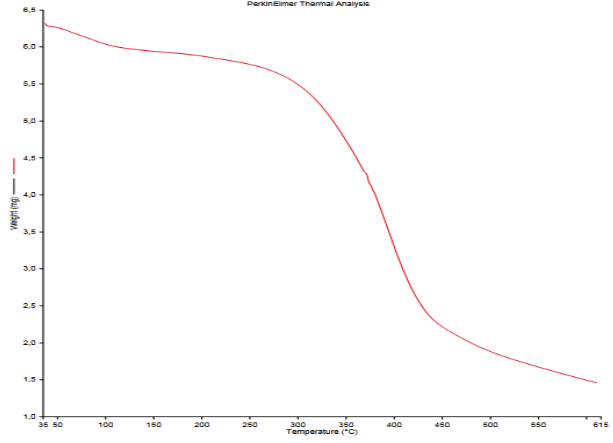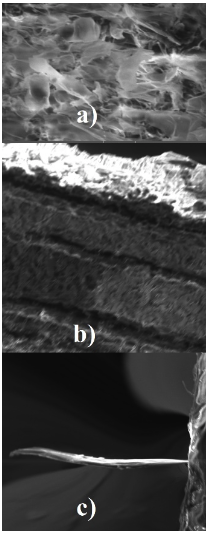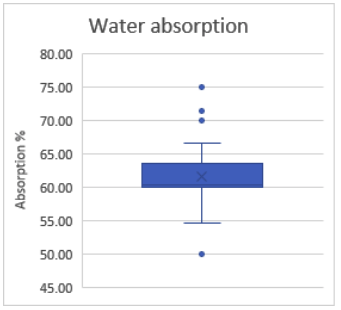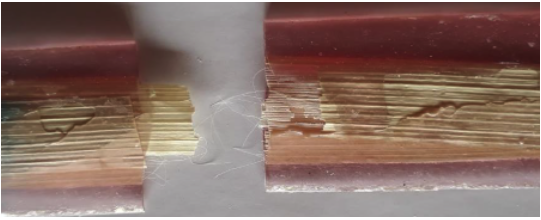

Vol. 41 (Issue 08) Year 2020. Page 13
NICOLALDE, Juan Francisco 1; MARTINEZ-GÓMEZ, Javier 2 y MAIGUASHCA, Javier 3
Received: 04/09/2019 • Approved: 04/03/2020 • Published 12/03/2020
ABSTRACT: Some of Ecuador’s flora hasn’t been characterized, this paper searches the determine the mechanical, thermal and moisture absorption features of the leaf of the mocora palm, by means of tensile tests, scanning electron microscopy SEM, thermos-gravimetrical TGA analysis, water and resin absorption tests. The mocora presented 28Mpa strength as a single strap and as a braid an elongation 23.43%, thermally showed a resistance to degradation near de 300®C, relate with SEM observation the leaf of mocora have a cover and for this reason the water take some time to be absorbed. |
RESUMEN: Parte de la flora ecuatoriana no se ha caracterizado, esta investigación busca determinar las propiedades mecánicas, térmicas y absorción de humedad de la hoja de la palma mocora, mediante pruebas de tracción, microscopía electrónica de barrido MEB, análisis termogravimétrico ATG, pruebas de absorción de líquidos. La mocora presentó una resistencia de 28Mpa como una tira y trenzada una elongación del 23.43%, resistencia a la degradación térmica cerca de 300 ° C, en base a la observación por MEB la hoja de mocora presenta una cobertura, y es por esta razón que el agua tarda en ser absorbida. |
Ecuador has an outstanding diversity of flora, some of it has been given artisans applications like the leaf of the Astrocaryum standleyanum (Arecaceae) (Espinoza et al., 2018), (Martinez et al. 2017). It is known as the mocora palm, this plant can be found in the pacific coasts from Nicaragua to Ecuador (Martínez-Gómez et al., 2017). In this last location the artisans of Calceta province of Manabí, use the leaf of the mocora to manufacture hats, mats and even furniture like chairs and small tables as shown in figure 1 (Valencia, Montúfar, Navarrete, & Balslev, 2013).
Figure 1
Furniture made of mocora
(Valencia, Montúfar, Navarrete, & Balslev, 2013)

The leaf to be used has to be extracted of the palm from the ground, due to the difficulty of climb it is done with a long tool with a blade like a hook or just flat (Gaona et al. 2017). to be sustainable the leaves are harvested from three in three, so the ones that remains in the palm can fully expand itself, after the leaves are on the ground, it has no more from 3 days it is boiled and then dry to the sun by several days, some artisans smoke the processed leaf to give it a white color (Valencia, Montúfar, Navarrete, & Balslev, 2013) (Borgtoft, 1994). For the known applications it is predicted that the leaf has thermal and mechanical resistance that could be of the interest of some industries like the automotive or the aerospace (Beltran and Martínez-Gómez, 2019).
In the industries, the natural fibers that can be found for mechanical applications are variable, they can be catalog by its origin in bast for jute, banana, flax, and hemp, the category of leaves has the pineapple, sisal and pine, by other side the fiber fruit has coconut, cotton, and palm oil (George, Sreekala, & Thomas, 2001), (Acurio et al., 2018). Worldwide some important brands like Mercedes-Benz, Audi, Toyota and others has been use natural components for its cars as reinforce of some resins in door panels or structure beams, foams from plant origins or headboards made of natural fiber and others (Jawaid, Sapuan, & Alothman, 2016) (Tapia, Paredes, Simbaña, & Bermúdez, 2006). It is that over the years the regulations in America and Europe seeks to make the cars more efficient in environmental matters as reduce fuel consumption (Martínez et al., 2013), (Kastillo et al. 2017). So, by using natural components it helps to reduce weight (Kaluza, Kleeman, Fröhlich, Herrmann, & Vietor, 2017) (Alves, et al., 2010), other regulation like the ELV dictates since 2015 that the 85% of the car’s material must be reused or recycled (Johnson & Wang, 2002). In the aerospace industry the natural fibers are been use as reinforce in panels of aircrafts and as a replace of metals in racks, so it reduces the weight of the aircraft and there for make a significant save in fuel consumption (Balakrishnan, John, Pothen, Sreekala, & Thomas, 2016) (Scarponi & Messano, 2015). Another reason for using natural fibers is to replace glass fiber because when this has reach its life use the disposal of it is too expensive and bring some important environmental impacts (Mohanty, et al., 2005). Also, by using natural fibers the costs are reduced as the C02 kidnap, in fact the energy required to make a flax mat it’s the 17% of energy for a glass fiber mat (Holbery & Houston, 2006). In fact, some natural fibers although are not as strong as the glass fiber, they have better elastic properties (Chand & Fahim, 2008), that with the low processing cost makes them very attractive to the industries. Another important matter in using natural fibers is that even some of this element can’t be recycled, they have an easily disposal because of the natural degradation of light, oxidation, hydrolysis or the enzymatic decomposition induced by microorganisms to de carbon dioxide, methane or biomass in a period of time (Mohanty, et al., 2005) (Cooke, 1990).
Some of the fiber that has been characterized has shown different important properties, in table 1 is presented the minimum tensile strength of these, table 2 presents the minimal perceptual elongation of some fibers,
Table 1
Natural Fibers Minimum
Tensile Strength
Fiber |
Minimum Tensile Strength (MPA) |
Flax |
345 |
Hemp |
690 |
Jute |
393 |
Ramina |
400 |
Sisal |
468 |
Abacá |
430 |
Cotton |
287 |
Coconut |
131 |
(Chand & Fahim, 2008)
In their resarch of 2008 Salvador, Amigó, Nuez, Sahuquillo, Llorens & Marti made the thermalgravimetric analisys of flax, cotton, hemp, kenaf and sisal, where particularli the sisal shown a behaviour where at a temperature of 39,56 °C the fiber has lost 3,88% of its weigth and at a limit temperature of 244,12°C it has lost 19,6% of its weigth, at the 300°C the sisal has lost more than the 43% of weigth. (Salvador, et al., 2008).
Table 2
Fibers Minimal
% Elongation
Fiber |
Minimun Elongation % |
Cotton |
7 |
Yute |
1,5 |
Flax |
2,7 |
Hemp |
2 |
Kenaf |
1,6 |
Ramio |
3,6 |
Sisal |
2 |
Coconut |
30 |
Glass Tipe E |
0,5 |
Glass Tipe S |
2,8 |
Aramid |
3,7 |
Carbon (std.PAN) |
1,8 |
(Ku, et al., 2011)
The fiber will be acquired from the artisans in Calceta in the conditions that they use for its artisanal applications. The mechanical test will be done for a simple leaf by the ASTM D 2256-02 norm and the test to a braided strap by the ASTM 5034. The thermo-gravimetric analyses will be done with a sample of 6.337mg, starting with a temperature of 40°C, and step of 15°C per minute until reach 600°C, it will be analyzing the maximum degradation temperature for this heat rate so we can have a knowledge of the decomposition that the material faces over the temperature elevation (Betancourt, Gañan, Jimenez, & Cruz, 2009) (Rodriguez & Villegas, 2012). The scanning electron microscopy will be done with an HV of 15kV to 20kV also with a magnification from 500x to 1.6kx. For the impermeability tests will be use 50 samples of 30cm x 10cm and put on distilled water and see the water absorption within 24 hours, the samples will be weighted before and after the immersion and compare the percentage absorption by the next equation (Moreno, Trujillo, & Osorio, 2007):

Also 20 samples will be submerged in a solution of unsaturated polyester resin with 20% of styrene, 0.03% of MEK as catalyzer and 0.03% of cobalt octoate at 12% as activator like the fabricator advices.
Table 3 shows the result of the mechanical tests to de single leaf sample.
Table 3
Single leaf tensile strength test
Sample |
Load [N] |
Elongation [%] |
Average Thickness [mm] |
Average Wide [mm] |
Area [mm²] |
Tensile Strength [Mpa] |
1 |
159.0 |
1.08 |
0.368 |
20.950 |
7.699 |
20.65 |
2 |
207.0 |
1.89 |
0.380 |
15.360 |
5.837 |
35.46 |
3 |
95.0 |
1.55 |
0.270 |
12.100 |
3.267 |
29.08 |
4 |
158.0 |
1.48 |
0.447 |
10.740 |
4.801 |
32.91 |
5 |
207.0 |
1.61 |
0.398 |
17.625 |
7.006 |
29.55 |
6 |
186.0 |
1.67 |
0.337 |
15.720 |
5.298 |
35.11 |
7 |
99.2 |
1.47 |
0.452 |
9.500 |
4.294 |
23.10 |
8 |
142.0 |
1.99 |
0.405 |
15.010 |
6.079 |
23.36 |
9 |
207.0 |
2.20 |
0.515 |
16.300 |
8.395 |
24.66 |
10 |
177.0 |
2.16 |
0.395 |
15.900 |
6.281 |
28.18 |
|
Average |
28.21 |
||||
Stand.Dev |
5.21 |
|||||
Table 4 displays the results of percentage elongation in braided samples, in comparison of the tensile strength of the mocora leaf and other natural fibers this have a poor tensile strength, even the coconut that is the weakest of all the fibers has a minimum strength of 131Mpa, it surpasses the mocora’s maximum strength in near 3 times, this is a disadvantage for the mocora,neverthelessas it can be seen the average percentage elongation of the braided mocora leaf of 23.43% its superior to other natural fibers compared that has proved applications, the only one who surpasses the mocora leaf it’s the coconut but not by far, for this properties is that the artisans can use this natural product in furniture, it is important to highlight that the process of extraction of the mocora leaf its easier than the coconut process, also the mocora leaf can have an average length of 1m as a single straw.
Table 4
Percentage elongation
of braided samples
Sample |
Load (kgf) |
Load [N] |
Elongation [%] |
1 |
8.22 |
80.54 |
22.74 |
2 |
4.57 |
44.76 |
18.55 |
3 |
7.70 |
75.49 |
21.76 |
4 |
5.75 |
56.37 |
20.04 |
5 |
7.70 |
75.44 |
23.28 |
6 |
6.19 |
60.66 |
28.10 |
7 |
6.04 |
59.15 |
25.28 |
8 |
5.33 |
52.19 |
22.21 |
9 |
6.73 |
65.94 |
25.28 |
10 |
5.79 |
56.76 |
23.41 |
11 |
6.24 |
61.16 |
23.77 |
12 |
5.22 |
51.14 |
25.36 |
13 |
4.95 |
48.47 |
22.35 |
14 |
5.31 |
52.06 |
22.88 |
15 |
4.86 |
47.58 |
28.91 |
16 |
6.36 |
61.33 |
26.90 |
17 |
8.71 |
85.34 |
24.92 |
18 |
6.33 |
62.03 |
20.88 |
19 |
5.20 |
51.00 |
21.35 |
20 |
4.87 |
47.73 |
20.61 |
|
Average |
59.76 |
23.43 |
|
Stand.Dev. |
11.61 |
2.69 |
Figure 2 shows the curve of degradation for the mocora sample.
Figure 2
TGA thermogram
for mocora sample

Although the mocora it’s dried for several days under the sun, it keeps some water, the TGA shows that in a temperature of 100°C the sample has lost a 4.48% of weight, this represents the percentage of humidity within the leaf. At the 300°C the mocora has lost 13.42% of its mass and at this point starts the most important degradation, table 5 shows the behavior of the mocora in the same limits as the sisal of Salvador, Amigó, Nuez, Sahuquillo, Llorens & Marti.
Table 5
Mocora temperature behavior
Temperature [ºC] |
Mocora Mass Lost [%] |
39.56 |
0.8 |
244.12 |
8.8 |
300 |
13.58 |
As it can be seen at the beginning of the experiment the sisal fiber has lost 3.88% of its mass but the mocora only 0.8%, the critic point were the sisal stars an important degradation it’s at 244.12°C and have lost 19.6% of weight, the mocora at the same temperature has lost 8.8% of mass and finally when the mocora reaches its critical temperature at 300° the sisal its burning and have lost more than 43.59% of mass. This clearly demonstrate that the mocora leaf have a more important thermal resistance than the sisal, another data to be important is that the mocora has totally burn at near 450°C, this temperature its more important than all others fiber, for this it can be say that the mocora leaf have a retardant property that could be use in some applications.
Figure 6 shows the scanning electron microscopy made to the mocora leaf, as it can be seen in a, the cover its very hermetic, in 6.b a tear in the cover shows that internally the mocora have grooves to hold the internal fibers and a very arranged topology.
Figure 3
SEM micrographs
of Mocora sample

As difference of the sisal that it’s more chaotic (Salvador, et al., 2008), finally in 6.c, it can be seen that the internal fiber its totally flat and don’t have any node, to compare with the sisal in the research of Biardo, Zini, and Scandola in 2004, the fibers have nodes, this are effort concentrators (Biardo, et al., 2004), by this mean it can be say that part of the mocora have its elastically properties because of the lack of this nodes.
At the beginning of the test the samples didn’t have any absorption of water, in fact they floated and shown impermeability to the water, but after a day of rest in water it finally absorbed a lot of water, in the figure 8 it can be seen how it worked, with an average of absorption rate of 61%. Later in the resin test the impermeability property of the mocora was ratify when it didn’t present any absorption or wettability from the mocora to the resin, before it can be absorbed the resin have cured, in figure 9 it can be seen a sample broke showing none interaction, in the research of Mishra, Mohanty, Drzal, Misra, Parija, Nayak, & Triphathy 0f 2003, shows the SEM of the flax-glass fiber-polyester resin compound where it can be seen that the absorption of the resin must be easy (Mishra, et al., 2003).
Figure 4
Water absorption

-----
Figure 5
Resine mocora interaction

The mocora leaf don’t have a weak tensile strength by its own and an average percentage strength but, as a braided configuration shows a very important percentage elongation very superior to all other compared fibers, except for the coconut, for this, the braided mocora leaf could have some applications that requires this property like the coconut headers.
The mocora showed a very important thermal resistance and even some heat retardant property, even superior to all other natural fibers compared, for this the mocora could be used as tapestry for cars or aircrafts.
The mocora has some important water absorption, but the time required for this it’s very high, its cover gives some impermeability and hermetical to the inner fibers that are the ones who finally take all the moisture to the inside of the fiber, in the case of the resin don’t have any interaction because of the cure time, for this, the mocora leaf could have some applications were permeability should be needed.
Acurio, K., Chico-Proano, A., Martínez-Gómez, J., Ávila, C. F., Ávila, Á., & Orozco, M. (2018). Thermal performance enhancement of organic phase change materials using spent diatomite from the palm oil bleaching process as support. Construction and Building Materials, 192, 633-642.
Alves, C., Ferrão, P., Silva, A., Reis, L., Freitas, M., Rodrigues, L., & Alves, D. (2010). Ecodesign of automotive components making use of natural jute fiber composites. Journal of cleaner production, 313-327.
Balakrishnan, P., John, M., Pothen, L., Sreekala, M., & Thomas, S. (2016). Natural fiber and polymer matrix composites and their application in aerospace engineering. Advanced Composite Materials for Aerospace Engineering , 365-383.
Beltrán, R. D., & Martínez-Gómez, J. (2019). Analysis of phase change materials (PCM) for building wallboards based on the effect of environment. Journal of Building Engineering, 24, 100726.
Betancourt, S., Gañan, P., Jimenez, A., & Cruz, L. J. (2009). Degradacion térmica de fibras naturales procedentes de la calceta de plátano (Estudio cinético). X CongresoIberoamericano de Metalurgia y Materiales IBEROMET (págs. 215-219). Cartagena: Revista LatinoAmericana de Metalurgia y Materiales.
Biardo, M., Zini, E., & Scandola, M. (2004). Flax fiber - polyester composites. Composites: Part A, 703-710.
Borgtoft, H. (1994). Mocora Palm-Fibers: Use and Managment of astrocaryum standleyanum (arecaceae) in Ecuador. Economic Botany, 310-325.
Chand, N., & Fahim, M. (2008). Tribology of natural fiber polymer composites. Boca Ratón: WoodHead Publishing .
Cooke, T. M. (1990). Biodegradability of polymers and fibers - A review . Journal of polymer engineering, 172-207.
Espinoza, V. S., Guayanlema, V., & Martínez-Gómez, J. (2018). Energy Efficiency Plan Benefits in Ecuador: Long-range Energy Alternative Planning Model. International Journal of Energy Economics and Policy, 8(4), 52-54.
Gaona, D., Urresta, E., Marínez, J., & Guerrón, G. (2017). Medium-temperature phase-change materials thermal characterization by the T-History method and differential scanning calorimetry. Experimental Heat Transfer, 30(5), 463-474.
George, J., Sreekala, M. S., & Thomas, S. (2001). A review on interface modification and characterization of natural fiber reinforced plastic composites. Polymer engineering and science, 1471-1485.
Holbery, J., & Houston, D. (2006). Natural fiber Reinforced Polymer Composites in Automotive Applications. JOM, 80-86.
Jawaid, M., Sapuan, S. M., & Alothman, O. J. (2016). Green Biocomposites Manufacturing and Properties. Gewerbestrasse: Springer.
Johnson, M. R., & Wang, M. H. (2002). Evaluation policies and automotive recovery otions according to the european union directive on end-of-life vehicles (ELV) . Proceedings of the instituition of mechanical engineers Part D: Journal Automobile Engineering, 723-739.
Kaluza, A., Kleeman, S., Fröhlich, T., Herrmann, C., & Vietor, T. (2017). Courrent design & life cycle engineering in automotive lightweight component development. 1st CIRP Conference on Composite Materials Parts Manufacturing (págs. 16-21). Württenberg: CIRP.
Kastillo, J. P., Martínez-Gómez, J., Villacis, S. P., & Riofrio, A. J. (2017). Thermal Natural Convection Analysis of Olive Oil in Different Cookware Materials for Induction Stoves. International Journal of Food Engineering, 13(3).
Ku, H., Wang, H., Pattarachaiyakoop, N., & Trada, M. (2011). A review on the tensil properties of natural fiber reinforced polymer composites. Composites: Part B, 856-873.
Martínez, J., Savoini, B., Monge, M. A., Munoz, A., Armstrong, D. E. J., & Pareja, R. (2013). Thermal stability of the grain structure in the W-2V and W-2V-0.5 Y2O3 alloys produced by hot isostatic pressing. Fusion Engineering and Design, 88(9-10), 2636-2640.
Martínez, J., Martí-Herrero, J., Villacís, S., Riofrio, A. J., & Vaca, D. (2017). Analysis of energy, CO2 emissions and economy of the technological migration for clean cooking in Ecuador. Energy Policy, 107, 182-187.
Martínez-Gómez, J., Guerrón, G., & Riofrio, A. J. (2017). Analysis of the “Plan Fronteras” for clean cooking in Ecuador. International Journal of Energy Economics and Policy, 7(1), 135-145.
Mishra, S., Mohanty, A. K., Drzal, L. T., Misra, M., Parija, S., Nayak, S. K., & Triphathy, S. S. (2003). Studies on mechanical performance of biofiber/glass reinforced polyster hybrid composites. Composites science and technology, 1377-1385.
Mohanty, A. K., Misra, M., Drzal, L. T., Selke, S. E., Harte, B. R., & Hinrichsen, G. (2005). Natural fibers, Biopolymers and Biocomposites: An introduccion. En A. K. Mohanty, M. Misra, & L. T. Drzal, Natural fibers, Biopolymers and Biocomposites (págs. 1-35). Boca Raton: Taylor & Francis Group.
Moreno, L. E., Trujillo, E., & Osorio, L. (2007). Estudio de las carcaterísticas físicas de haces de fibra guadua angustifolia. Scientia et Technia año XIII, 613-617.
Rodriguez, E., & Villegas, E. (2012). Caracterzación de polímeros aplicando el método termogravimétrico. Métodos y Materiales, 25-32.
Salvador, M., Amigó, V., Nuez, A., Sahuquillo, O., Llorens, R., & Marti, F. (2008). Caracterización de fibras vegetales utilizadas como refuerzo en matrices termoplásticos. X Congreso Nacional de Materiales (págs. 1-4). San Sebastian: Universidad Politécnica de Valencia.
Scarponi, C., & Messano, M. (2015). Comparative evaluation between E-Glass and hemp fiber composites application in rotorcraft interiors. Composites: Part B, 542-549.
Tapia, C., Paredes, C., Simbaña, A., & Bermúdez, J. (2006). Aplicación de las fibras naturales en el desarrollo de materiales compuestos y como biomasa. Revista tecnológica ESPOL, 113-120.
Valencia, R., Montúfar, R., Navarrete, H., & Balslev, H. (2013). Palmas Ecuatorianas: biología y uso sostenible. Quito: Herbario QCA de la Pontifica Universidad Católica del Ecuador.
1. MSC at Universidad Internacional SEK (UISEK) Ecuador; email: jnicolalde.mdm@uisek.edu.ec
2. Academic staff at Universidad Internacional SEK (UISEK) Ecuador. Research at Instituto de Investigación Geológico y Energético (IIGE), Quito, Ecuador; e-mail: javier.Martinez@uisek.edu.ec
3. Research at Instituto Espacial Ecuatoriano; e-mail: javier.maiguashca@institutoespacial.gob.ec
[Index]
revistaespacios.com

This work is under a Creative Commons Attribution-
NonCommercial 4.0 International License